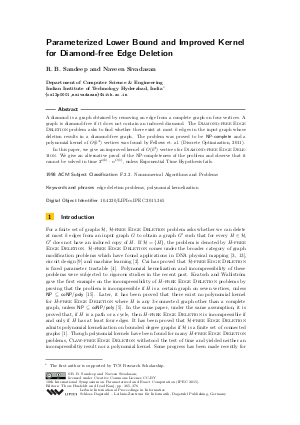Parameterized Lower Bound and Improved Kernel for Diamond-free Edge Deletion
Authors R. B. Sandeep, Naveen Sivadasan
-
Part of:
Volume:
10th International Symposium on Parameterized and Exact Computation (IPEC 2015)
Part of: Series: Leibniz International Proceedings in Informatics (LIPIcs)
Part of: Conference: International Symposium on Parameterized and Exact Computation (IPEC) - License:
 Creative Commons Attribution 3.0 Unported license
Creative Commons Attribution 3.0 Unported license
- Publication Date: 2015-11-19
File

PDF
LIPIcs.IPEC.2015.365.pdf
- Filesize: 485 kB
- 12 pages
Document Identifiers
Subject Classification
Keywords
- edge deletion problems
- polynomial kernelization
Metrics
- Access Statistics
-
Total Accesses (updated on a weekly basis)
0PDF Downloads0Metadata Views
Abstract
A diamond is a graph obtained by removing an edge from a complete graph on four vertices. A graph is diamond-free if it does not contain an induced diamond. The Diamond-free Edge Deletion problem asks to find whether there exist at most k edges in the input graph whose deletion results in a diamond-free graph. The problem was proved to be NP-complete and a polynomial kernel of O(k^4) vertices was found by Fellows et. al. (Discrete Optimization, 2011).
In this paper, we give an improved kernel of O(k^3) vertices for Diamond-free Edge Deletion. We give an alternative proof of the NP-completeness of the problem and observe that it cannot be solved in time 2^{o(k)} * n^{O(1)}, unless the Exponential Time Hypothesis fails.
Cite As Get BibTex
R. B. Sandeep and Naveen Sivadasan. Parameterized Lower Bound and Improved Kernel for Diamond-free Edge Deletion. In 10th International Symposium on Parameterized and Exact Computation (IPEC 2015). Leibniz International Proceedings in Informatics (LIPIcs), Volume 43, pp. 365-376, Schloss Dagstuhl – Leibniz-Zentrum für Informatik (2015)
https://doi.org/10.4230/LIPIcs.IPEC.2015.365
BibTex
@InProceedings{sandeep_et_al:LIPIcs.IPEC.2015.365,
author = {Sandeep, R. B. and Sivadasan, Naveen},
title = {{Parameterized Lower Bound and Improved Kernel for Diamond-free Edge Deletion}},
booktitle = {10th International Symposium on Parameterized and Exact Computation (IPEC 2015)},
pages = {365--376},
series = {Leibniz International Proceedings in Informatics (LIPIcs)},
ISBN = {978-3-939897-92-7},
ISSN = {1868-8969},
year = {2015},
volume = {43},
editor = {Husfeldt, Thore and Kanj, Iyad},
publisher = {Schloss Dagstuhl -- Leibniz-Zentrum f{\"u}r Informatik},
address = {Dagstuhl, Germany},
URL = {https://drops.dagstuhl.de/entities/document/10.4230/LIPIcs.IPEC.2015.365},
URN = {urn:nbn:de:0030-drops-55976},
doi = {10.4230/LIPIcs.IPEC.2015.365},
annote = {Keywords: edge deletion problems, polynomial kernelization}
}
Author Details
References
-
N. R. Aravind, R. B. Sandeep, and Naveen Sivadasan. On polynomial kernelization of ℋ-free edge deletion. In Parameterized and Exact Computation, pages 28-38. Springer International Publishing, 2014.

-
Nikhil Bansal, Avrim Blum, and Shuchi Chawla. Correlation clustering. Machine Learning, 56(1-3):89-113, 2004.

-
Hans L. Bodlaender and Babette van Antwerpen-de Fluiter. On intervalizing k-colored graphs for DNA physical mapping. Discrete Applied Mathematics, 71(1-3):55-77, 1996.

-
Leizhen Cai. Fixed-parameter tractability of graph modification problems for hereditary properties. Inf. Process. Lett., 58(4):171-176, 1996.

-
Leizhen Cai and Yufei Cai. Incompressibility of H-free edge modification problems. Algorithmica, 71(3):731-757, 2015.

-
Yufei Cai. Polynomial kernelisation of H-free edge modification problems. Mphil thesis, Department of Computer Science and Engineering, The Chinese University of Hong Kong, Hong Kong SAR, China, 2012.

-
Marek Cygan, Marcin Pilipczuk, Michał Pilipczuk, Erik Jan van Leeuwen, and Marcin Wrochna. Polynomial kernelization for removing induced claws and diamonds. In WG, 2015.

-
Pål Grønås Drange and Michał Pilipczuk. A polynomial kernel for trivially perfect editing. In ESA, 2015.

-
Ehab S El-Mallah and Charles J Colbourn. The complexity of some edge deletion problems. Circuits and Systems, IEEE Transactions on, 35(3):354-362, 1988.

-
A Farrugia. Clique-helly graphs and hereditary clique-helly graphs, a mini-survey. Algoritmic graph theory (CS 762)-2002-Project, Dept. of Comb., University of Waterloo, 2002.

-
Michael R. Fellows, Jiong Guo, Christian Komusiewicz, Rolf Niedermeier, and Johannes Uhlmann. Graph-based data clustering with overlaps. Discrete Optimization, 8(1):2-17, 2011.

-
M. R. Garey, David S. Johnson, and Larry J. Stockmeyer. Some simplified NP-complete graph problems. Theor. Comput. Sci., 1(3):237-267, 1976.

-
Paul W. Goldberg, Martin Charles Golumbic, Haim Kaplan, and Ron Shamir. Four strikes against physical mapping of DNA. Journal of Computational Biology, 2(1):139-152, 1995.

-
Russell Impagliazzo, Ramamohan Paturi, and Francis Zane. Which problems have strongly exponential complexity? J. Comput. Syst. Sci., 63(4):512-530, 2001.

-
Stefan Kratsch and Magnus Wahlström. Two edge modification problems without polynomial kernels. Discrete Optimization, 10(3):193-199, 2013.

-
Bojan Mohar. Face covers and the genus problem for apex graphs. J. Comb. Theory, Ser. B, 82(1):102-117, 2001.

-
Stephan Olariu. Paw-fee graphs. Inf. Process. Lett., 28(1):53-54, 1988.

